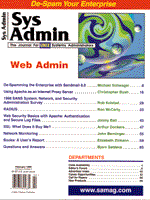Listing 4: Perl program for signing client certificate
#!/usr/local/bin/perl
$SECURITYPASSWD="Geheim";
$CAROOT="demoCA";
%certdata;
sub passwderr {
print <<EOM
Password error<BR>
EOM
;
}
foreach (@ARGV) {
s/\n//g;
my( $key, $value ) = split( /=/ );
if( $key eq "passwd" ) {
chop $value;
$passwd = $value;
}
else {
$certdata{$key} = $value;
}
}
# Get the serial number
open SERIAL, $CAROOT . "/serial" or die "CA serial file error: $!\n";
$serial = <SERIAL>;
chomp $serial;
close SERIAL;
# Write the request file
open CERT, "> requests/request.$serial";
foreach $key (keys %certdata) {
print CERT "$key=$certdata{$key}\n";
}
close CERT;
# Call the ca program to sign
open CA, "/usr/local/ssl/bin/ca -key $passwd -spkac \
requests/request.$serial -outdir certs -
batch|" or die "CA: $!\n";
my @log = <CA>;
close CA;
# Present the certificate to the user so he or she can install it
print <<EOM
<html>
<head>
<title>Your personal Security Certificate has been generated</title>
</head>
<BODY TEXT="#FFFF00" BGCOLOR="#7F7F7F" LINK="#FFD700" \
VLINK="#FFD700" ALINK="#FF0000">
<hr size=5>
<h1>Your personal Security Certificate has been generated</h1>
<hr>
<p>
Click <a href="/userinstall.phtml?serial=$serial">here</a> to \
install your certificate.
</p>
<hr>
<p>
Click <a href="/test.phtml">here</a> to test your certificate.
</p>
<hr>
</body>
</html>
EOM
;
# End of File
|
